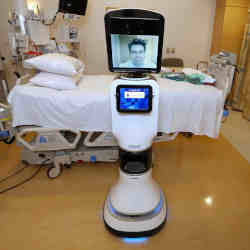
As society looks for ways to reduce human exposure to novel coronavirus, digital technology has emerged front stage center. Computers, smartphones, videoconferencing tools and cloud-based services have curtailed the need for people to congregate, and risk becoming sick or dying.
Yet, for many tasks — tending to patients in hospitals, managing grocery stores, delivering food — social distancing is not an option. Human workers can't escape the risk of being exposed to COVID-19.
Enter robotics.
"Robots can greatly aid in reducing risk in many situations and environments," says Howie Choset, Kavcic-Moura Professor of the Computer Science Robotics Institute and co-director of the Biorobotics Lab at Carnegie Mellon University.
With social distancing likely to continue for months or longer, robotic devices are increasingly valuable as front-line surrogates for people. In India and China, robots now tend to patients in isolation wards of hospitals. Around the world, grocery stores are turning to robots to manage inventory and to avoid shortages. Also, robots now disinfect public spaces and deliver food and supplies to businesses and homes.
Dialing Down Risk
The idea of using robots to address difficult and risky tasks is not new. However, improved mobility, sensing, and navigation capabilities have made it possible for these devices to do things that wouldn't have seemed possible a few years ago. What's more, machine learning and onboard speech recognition have simplified once-complex interfaces and helped streamline robotic interactions with people.
"Robotics technology is rapidly moving out of the lab and into the real world," says Russell H. Taylor, John C. Malone Professor of Computer Science and director of the Laboratory for Computational Sensing and Robotics at Johns Hopkins University. "Devices are increasingly able to operate successfully in unstructured environments, including buildings and streets."
For example, Wuhan Wuchang Smart Field Hospital in China recently used 14 humanoid robots to treat patients in isolation wards. The robots, which cost between $17,000 and $72,000 each, came from robotics firm CloudMinds. Danish firm UVD Robots has designed robots that move around in a medical facility or other space and sanitize the environment using UV surface disinfection systems. Still others, such as food delivery service Postmates, have developed robots that can navigate streets and people and deliver food to homes several blocks away.
"The pandemic has highlighted opportunities for robotics, automation, and better data," says Brad Bogolea, CEO and co-founder of Simbe Robotics Inc. His firm's robot, Tally, already in use by a dozen retailers in six countries, navigates stores and scans inventory using more than a dozen on-board cameras and other sensors. The 6-foot-tall, 18-inch-wide robot operates during normal store hours and has no problem yielding to people and shopping carts, thanks to lidar and a differential drive base.
Using two-dimensional and three-dimensional scans, artificial intelligence, and 360-degree awareness, Tally reads RFID tags and printed shelf tags as it navigates aisles, comparing items to an image database in real time. It identifies inventory levels, misplaced items, and trend analysis data. "With enormous pressure on inventory during the pandemic, it helps stores restock more effectively and allows associates to spend less time in aisles and engage in higher value tasks," Bogolea says.
Robotics deliver two major benefits in public-facing environments, Choset says. First, they reduce risk for staff—from doctors and nurses to clerks and cashiers—by reducing direct contact with potentially infected people. Second, "They can serve as a force multiplier. They allow healthcare workers to focus on high-value tasks." With some near-term development, Choset says, robots could administer COVID-19 tests, take temperatures and other vitals, monitor healthcare workers for signs of infection, and even serve "social" functions in isolation wards.
A Robotic Future
Despite remarkable advancements in robotics, practical and technical challenges remain. For example, while robots already can navigate buildings, streets, traffic signals, and around people, "There is still the problem of systems that can't perceive how humans perceive and fail when they encounter exceptions," Taylor says. Mobile robots must be able to deal with circumstances beyond their current training set; say, working in a medical tent instead of a clearly defined room.
Nevertheless, as robots gain additional capabilities and become part of a post-pandemic society, they likely will usher in bigger and more permanent changes, Taylor says. Acceptance is growing, but questions about their role remain. "So far, robots have mostly been used for niche purposes in responding to the pandemic—things like lab automation and fulfillment centers—but they can play a much larger role in future crises."
Taylor believes far more specialized robots will emerge over the next few years. These systems will likely be adapted to specific conditions and circumstances, such as an Intensive Care Unit or a nursing home. "The COVID crisis has confirmed that there are large opportunities and large needs in this area. It would be wise to learn from what works and what doesn't work and prepare for using robots in future crises."
Samuel Greengard is an author and journalist based in West Linn, OR, USA.



Join the Discussion (0)
Become a Member or Sign In to Post a Comment